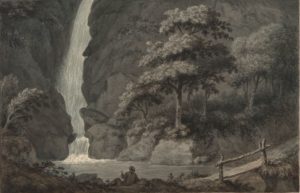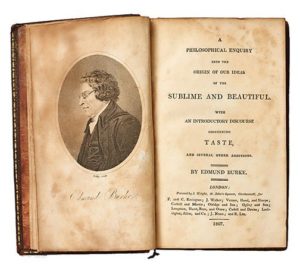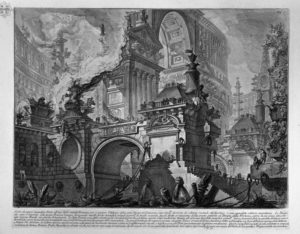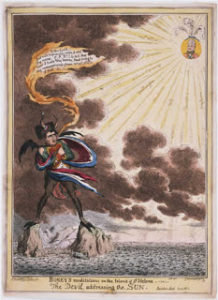The sublime is a sense of inner greatness of the soul and a sense of overcoming any difficulty. The realisation of the sublime proves to be a sensation of inadequacy and conquest of mind. Sublime has always been related to the grandeur that fuels awe and wonder.
For artists and writers, sublime has always given them the basis of inspiration, generally in relation to beauty. The idea of sublime has been discovered and interpreted in a different way over the years, from the early period of baroque to the existing day.
The sublime in the judgements of history has a cavernous meaning, relating it to something actually amazing. The sublime is also approached with awe evoking, uneasiness, fear and danger instead of responding them with objects relating to beauty.
The mountains, caves, oceans and cathedrals are the major sublime bodies which are full of happiness and joy but induces terror when they are made to face them in reality.
Sublimity to Edmund Burke
Edmund Burke, one of the famous British artist and writer on art have travelled around to acquire conclusions on sublime. Edmund Burke’s orientations on the fundaments of sublime are very different from other writers and poets.
I know of nothing sublime which not some modification of power is.-EDMUND BURKE
After concluding from the observations of John Locke, Burke says that all our consciousness comes to us either by experiences; from modest to complex ones. For Burke imagination is firmly related to the idea of ‘fancy’ given by Coleridge. In the thoughts of Burke ‘new’ cannot be a part of every imaginative craft.
Large and grand parts of nature are associated with the sublime whereas beauty is oblivious in small parts. He catches a difference between what occurs and what the mind expects in a situation. The fear of death, disintegration, fright, and darkness are closely related to feelings of sublime. Burke says: whatever is in any kind dreadful, or is accustomed about dreadful objects, or goes in a manner similar to terror, is a source of the sublime; that is, it is prolific of the hardest feeling which the mind is adept of feeling.
This outset of the sublime by Burke proved to be significant for several generation and artists re-joining in the later eighteen century to add the sublime with objects of wreck and psychoanalysis. In the words of Edmund Burke, the most sublime entity is nature which is very much capable of creating a sensation of robust in the eyes of the beholder.
The desire which alarms self-preservation, turn commonly in ache and threat-EDMUND BURKE.

Wordsworth Sublime
In the language of Wordsworth, a mysterious state of mind confined in the beholder is what the sublime is supposed to cause. The sublime is perfectly seen in one of works of Wordsworth, that is, The Prelude which includes lines; “The Power which these / Acknowledge when thus moved, which Nature thus / Thrusts forth upon the senses.”The major power which is the emotion conjures a kind of bewilderment and surprise in the mind of the poet.
That precise emotion is captured in the flashes when the first sight is set upon the Mount Snow down by the poet. Rousseau’s in his last work Reveries of a Solitary Walker records how Wordsworth writes about his own-self and his experiences with nature. The sublime is beyond language and words and pure art is the only pure art which is capable of expressing. Beauties of nature directly eye witness the sublime.
The Sublime and Beautiful
In the word of Wordsworth sublime and the Beautiful; a far-seeing mountain of the Langdale pike is being appreciated—next, the readers are asked to turn their sight towards that gathering of Mountains at the Head of Windermere.
They are only assumed of as the crown a wide-ranging as these objects are put into a distance. Landscape: if the false theories do not divert our minds by false theories unless those mountains would have been seen under some natural accidents, and only an outstanding print would be established of them.
But if they are being observed from a point which has brought us quite close that the only object of the eyes is the mountains, yet not so proximate but that the whole of it is observable, we shall be overwhelmed with an impression of sublimity.
If observed very deeply, a sense of individual form or forms; duration as a sense; and a sense of power. And power which always yields the sublime whether as it is believed of as a thing to be frightened, to be attacked, or that can be shared.

Coleridge and Sublime
Samuel Taylor Coleridge, the highly intellectual poet of the romantic revival, was a dreamer and a vision holder. For Coleridge, ‘fancy’ is something which merely assembles and juxtaposes images and impression without fusing them.
Coleridge transforms his external world with his imagination, brings them to life ‘for objects, as objects are essentially fixed and dead.’ The unifying power of imagination is what he calls ‘esemplastic’.Conflict of contrariety or a diverse practice of pleasure and ache are never rooted in sublimity.
“Resistance to fate and nature, and the repose of the hyper-tragic histrionic stoicism borrowed from the late theories of Greek drama”.
He never tolerated any form of crisis as a portion of the sublime experience and as for the dominant attitude he had no compassion in the German sublime. A peculiar atmosphere is crafted by Coleridge in his poetry to enhance sublimity. ‘The Ancient Mariner’ is awfully sublime and shrouded in mystery.
The poem starts with the exploration of the sublime and gives an insight into the understanding of the sublime of Coleridge. The first gaze of sublimity comes with the arrival of the ancient mariner along with his crew.
The most important thing here is the cruelty of nature bringing along the true feature of the sublime. “Nor shapes of men nor beasts we ken-|The ice was all between”. The ice is what the mariner sees wherever he looks and in such a situation he sees the monstrous beauty of nature
For the band of poets that are dredged up for their consecration to the expression of emotions, the custom of negatives shines brightly through the order of the Sublime. Readers are being occupied momentarily beyond humans with the lyrical ballads, lyrics, odes and stanzas.
Such is the paradox of the Sublime. The mysterious power influx that has given poetry the higher hand among the Romantics. ‘The verse will be read a hundred times where the prose is read once.’ lies the hunt of sublimity in romantic poetry.’-by Wordsworth remains the final pronouncement.
The sublime and modern architecture.
Individuals are paid out and demarcated by architecture. A multitude of the variability of diverse aesthetic whereabouts is uncovered to the people through architecture. Architecture thus gives a breathed understanding. Culture pervades in every aspect of our lives in today’s capitalism.
From our homes to the public streets its presence is seen everywhere. The relationship between man and nature has been changed by traditional technology, thus dropping the vacillation of our survival fight.

Yes, man has dominated nature and now the challenge that hails from the opposed side of the spectrum from man’s knowledge and its instrumented form of technology is intense.
In recent years the prominence of the sublime for twentieth-century architecture is developing in critical writing.
The emotion of sublime is not stimulated in Banal architecture, only strengthens the current modes of fabrication of the global capitalist market and obliges us to ponder one-dimensionally.
Banal architecture and sublime architecture both call for more consideration.
Sublime architecture has a key role to play in the architectural experience get the most out of our own self-determination and the pessimism of our subjectivity is also discovered and motivates us to think multi-dimensionally.
Byronic sublime
Lord Byron was engaged with the philosophical writings on the sublime; by the Greek ancient writer Longinus, and also with the eighteenth-century theorist Edmund Burke. From these theories develops the definition of what is called the ‘BYRONIC SUBLIME’.
The major poems of Byron Don Juan and Childe Harold’s Pilgrimage outlook as two poetical accomplishments. Byron in the poem, Don Juan, displays how in a sturdy sense the sublime does without a doubt approach on the preposterous.
In Byron’s poetry, the most crucial thing is the role of freedom and in Don Juan, Byron chains his passionate thoughts on free love and liberty.

This is reflected to be the highest form of sublimity for the reason that an individual’s mind and body is enlightened entirely and a complete obsession in sexual pleasure is thus endorsed.
The theory of sublimity that expresses a belief in the liberty of mind, body and expression is what the Byronic sublime is all about.
It allows the individual to open themselves completely to the sensation of sublime. The Byronic sublime is all about living in liberty.